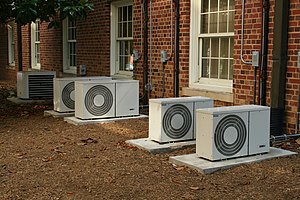
Back حرارة مهدرة Arabic বর্জ্য তাপ Bengali/Bangla Calor residual Catalan Abwärme German Calor residual Spanish Heitsoojus Estonian گرمای زاید Persian Chaleur de récupération French Zafin hayaƙi Hausa Otpadna toplina Croatian


Waste heat is heat that is produced by a machine, or other process that uses energy, as a byproduct of doing work. All such processes give off some waste heat as a fundamental result of the laws of thermodynamics. Waste heat has lower utility (or in thermodynamics lexicon a lower exergy or higher entropy) than the original energy source. Sources of waste heat include all manner of human activities, natural systems, and all organisms, for example, incandescent light bulbs get hot, a refrigerator warms the room air, a building gets hot during peak hours, an internal combustion engine generates high-temperature exhaust gases, and electronic components get warm when in operation.
Instead of being "wasted" by release into the ambient environment, sometimes waste heat (or cold) can be used by another process (such as using hot engine coolant to heat a vehicle), or a portion of heat that would otherwise be wasted can be reused in the same process if make-up heat is added to the system (as with heat recovery ventilation in a building).
Thermal energy storage, which includes technologies both for short- and long-term retention of heat or cold, can create or improve the utility of waste heat (or cold). One example is waste heat from air conditioning machinery stored in a buffer tank to aid in night time heating. Another is seasonal thermal energy storage (STES) at a foundry in Sweden. The heat is stored in the bedrock surrounding a cluster of heat exchanger equipped boreholes, and is used for space heating in an adjacent factory as needed, even months later.[1] An example of using STES to use natural waste heat is the Drake Landing Solar Community in Alberta, Canada, which, by using a cluster of boreholes in bedrock for interseasonal heat storage, obtains 97 percent of its year-round heat from solar thermal collectors on the garage roofs.[2][3] Another STES application is storing winter cold underground, for summer air conditioning.[4]
On a biological scale, all organisms reject waste heat as part of their metabolic processes, and will die if the ambient temperature is too high to allow this.
Anthropogenic waste heat can contribute to the urban heat island effect.[5] The biggest point sources of waste heat originate from machines (such as electrical generators or industrial processes, such as steel or glass production) and heat loss through building envelopes. The burning of transport fuels is a major contribution to waste heat.
- ^ Andersson, O.; Hägg, M. (2008), "Deliverable 10 - Sweden - Preliminary design of a seasonal heat storage for IGEIA – Integration of geothermal energy into industrial applications Archived 11 April 2020 at the Wayback Machine, pp. 38–56 and 72–76, retrieved 21 April 2013
- ^ Wong, Bill (June 28, 2011), "Drake Landing Solar Community" Archived 2016-03-04 at the Wayback Machine, IDEA/CDEA District Energy/CHP 2011 Conference, Toronto, pp. 1–30, retrieved 21 April 2013
- ^ Wong B., Thornton J. (2013). Integrating Solar & Heat Pumps. Archived 2013-10-15 at the Wayback Machine Renewable Heat Workshop.
- ^ Paksoy, H.; Stiles, L. (2009), "Aquifer Thermal Energy Cold Storage System at Richard Stockton College" Archived 2014-01-12 at the Wayback Machine, Effstock 2009 (11th International) - Thermal Energy Storage for Efficiency and Sustainability, Stockholm.
- ^ Cite error: The named reference
:0was invoked but never defined (see the help page).